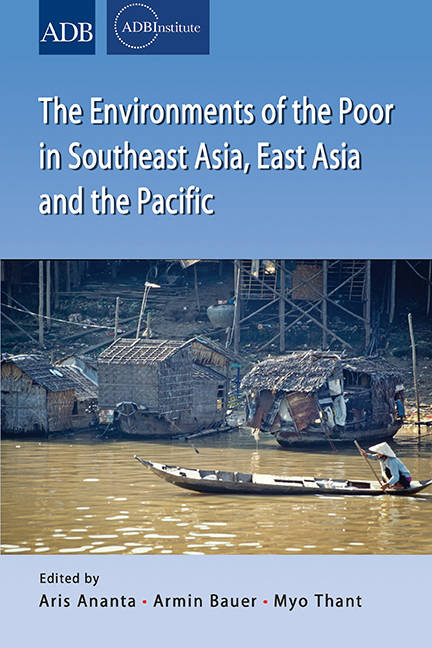Book contents
- Frontmatter
- Contents
- Preface
- List of Contributors
- Part I OVERVIEW
- Part II EAST ASIA (People's Republic of China and Republic of Korea)
- Part III PACIFIC ISLANDS
- Part IV MAINLAND SOUTHEAST ASIA (Cambodia, Thailand, Vietnam)
- 9 Poverty and the Environment in Rural Cambodia
- 10 Conservation Agriculture in Cambodia: A Triple-Win Option
- 11 Voices of the Poor on Climate Change in Thailand and Vietnam
- 12 Poor Thai Farmers' Adaptation to Climate Change
- Part V ARCHIPELAGIC SOUTHEAST ASIA (Indonesia, Malaysia, Philippines)
10 - Conservation Agriculture in Cambodia: A Triple-Win Option
from Part IV - MAINLAND SOUTHEAST ASIA (Cambodia, Thailand, Vietnam)
Published online by Cambridge University Press: 21 October 2015
- Frontmatter
- Contents
- Preface
- List of Contributors
- Part I OVERVIEW
- Part II EAST ASIA (People's Republic of China and Republic of Korea)
- Part III PACIFIC ISLANDS
- Part IV MAINLAND SOUTHEAST ASIA (Cambodia, Thailand, Vietnam)
- 9 Poverty and the Environment in Rural Cambodia
- 10 Conservation Agriculture in Cambodia: A Triple-Win Option
- 11 Voices of the Poor on Climate Change in Thailand and Vietnam
- 12 Poor Thai Farmers' Adaptation to Climate Change
- Part V ARCHIPELAGIC SOUTHEAST ASIA (Indonesia, Malaysia, Philippines)
Summary
The Mekong River runs through or along Myanmar, Laos, Thailand, Cambodia, and Vietnam. In these “Mekong countries”, agriculture provides a livelihood for a larger proportion of the population than the proportion of GDP derived from agriculture. Agriculture also functions as a safety net for the cities: many workers return to the country to work on farms when there is a rise in unemployment. But the degradation of the environment (soil fertility, erosion, increased population density) and climate change threaten the agriculture sector's ability to play these two roles. Plans must be implemented to keep the agriculture sector sustainable and competitive. Such plans must be adapted to the fact that farmers are financially fragile. Most of their revenue is absorbed by day-to-day expenses, and their investment capacity is low. Also, population growth has saturated the available cultivable lands. As the capacity of urban areas to accommodate rural migration has in most cases reached its limit, crop cultivation is being extended to less fertile areas, often with slopes where erosion happens. Such areas are typically in the peripheral region of Cambodia, the hilly areas of Sayaboury in Laos, and the highlands of Vietnam. As more and more marginal land is being cropped, the sustainability of this activity decreases and the rate of rural poverty increases. Within the Mekong countries rural poverty usually is higher than the national average, and it is higher than rural poverty elsewhere in Asia.
The Mekong countries agriculture is based on irrigated rice, but this system has reached its limits. For rain-fed agriculture, even on sloppy areas, direct sowing (or seeding) mulch-based cropping (DMC), also known as “no tillage” systems, is a better choice. This method was originally developed for tropical upland agriculture in central-west regions of Brazil. For some years, the Agence Française de Développement (AFD) funded research and development projects based on DMC. These projects were implemented with the technical and scientific support of the Centre de Coopération Internationale en Recherche Agronomique pour le Développement (CIRAD) in Cambodia, Laos, and Vietnam.
- Type
- Chapter
- Information
- Publisher: ISEAS–Yusof Ishak InstitutePrint publication year: 2013

